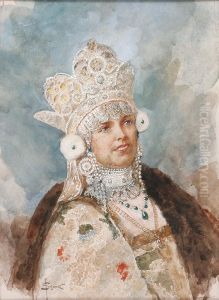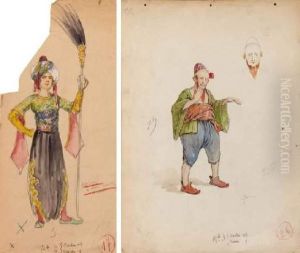Sergej Solomko Paintings
Sergej Solomko, born in 1867 in Russia, was a distinguished Russian artist, illustrator, and painter known for his profound influence on the visual culture of his time. Coming from a noble family, Solomko was exposed to the arts and culture from a young age, which significantly shaped his artistic development. He pursued his education at the Imperial Academy of Arts in Saint Petersburg, where he honed his skills and established a foundation for his future career. Solomko's work is characterized by its intricate detail, vibrant use of color, and often, themes that drew on Russian folklore, history, and literature.
Throughout his career, Solomko worked across various mediums, including watercolor, oil painting, and drawing. However, he is perhaps best remembered for his contributions to the field of illustration. He illustrated numerous books, magazines, and postcards, making his work widely accessible and popular among the Russian populace. His illustrations not only depicted scenes from everyday life and fairy tales but also served as critical commentaries on the social and political issues of his time.
Solomko's artistic style was influenced by the Art Nouveau movement, which was at its peak during his most productive years. He integrated the movement's characteristic curvilinear designs and emphasis on natural forms into his work, blending them with traditional Russian artistic elements. This fusion created a distinctive style that was both modern and deeply rooted in Russian heritage.
Despite the political upheavals in Russia during his lifetime, including the Russian Revolution of 1917, Solomko continued to produce art that resonated with a wide audience. After the revolution, like many of his contemporaries, he emigrated, eventually settling in Paris, where he continued his work until his death in 1928. In Paris, he became part of the Russian émigré community, contributing to its cultural life and continuing to work on illustrations, portraits, and scenography.
Sergej Solomko's legacy is preserved in museums, galleries, and private collections around the world. His work provides a window into the cultural and historical landscape of Russia at the turn of the 20th century, reflecting the nation's traditions, its transformations, and the personal vision of one of its most talented artists. Solomko's contributions to the world of art remain significant, showcasing the richness of Russian culture and the enduring appeal of his artistic vision.

